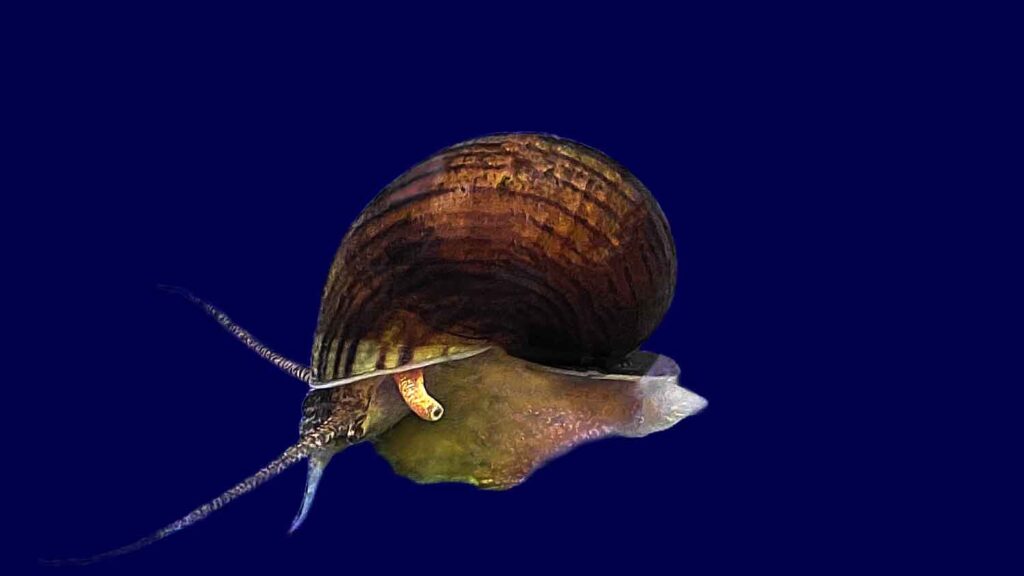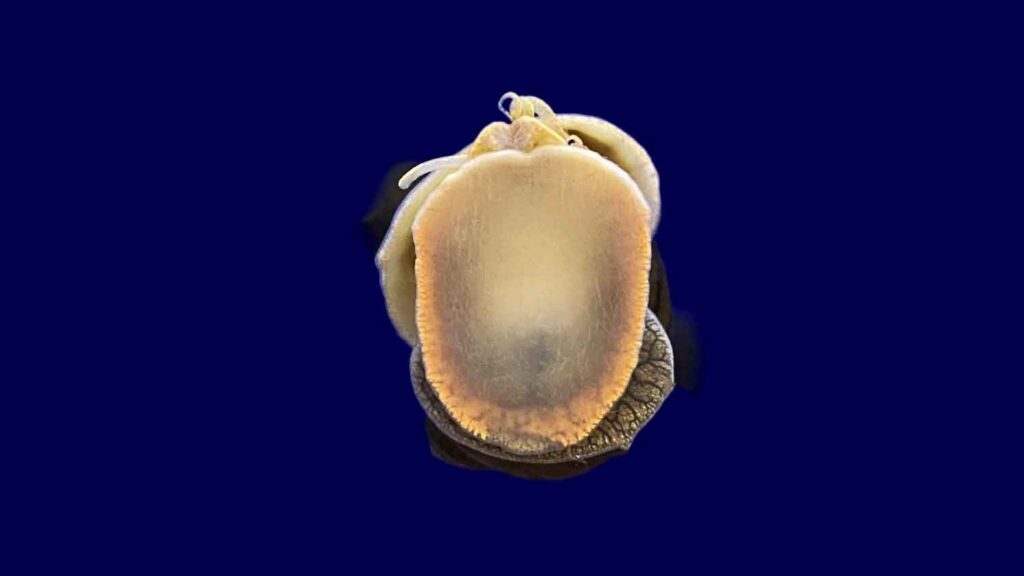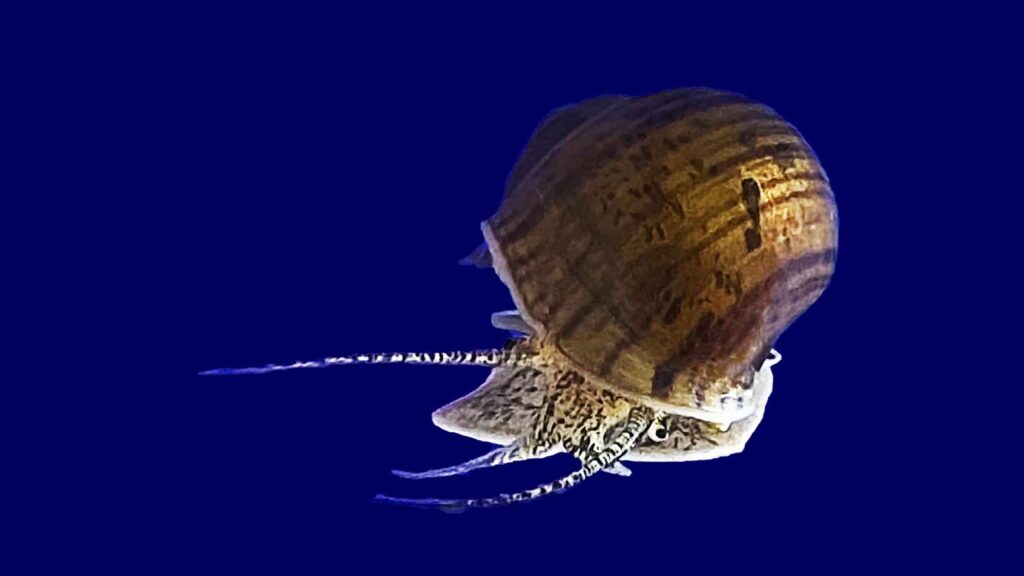The Mystery Snail (Pomacea bridgesii) is one of the most famous freshwater snails in the aquarium hobby. They grow to a decent size which makes it easy for viewers to find thin in the aquarium. The yellow and black varieties of them are the most famous and most available in pet stores. Their size and coloration can easily make them the focal point of your aquarium.
In this guide, we gathered all the information you need to create a perfect environment for your mystery snail.
Species Profile & Overview
Mystery Snails can be found in tropical regions of South America, parts of Africa as well as Asia. They are often mistaken for Apple Snails (Ampullariidae) and are sold under that name. They develop a natural brownish color on their shell and grow to a decent size. The mystery Snail’s shell can be a solid brown or bright creamy yellow. Some might also come in black or dark brown stripes.
These coloration varieties are mostly the result of line breeding by aquarium hobbyists and fisheries. Having said that, they will also produce beautiful colors and patterns naturally in the wild.
Mystery Snails reproduce rapidly and in high numbers and are considered pest snails in some parts of the world. They are often found in rivers and bodies of water that have lots of vegetation which they use as a food source. In the wild, the areas where they live, the water is always warm, clear, and well-oxygenated. Your Mystery Snail will thrive and live a happier life in your aquarium if you replicate a similar environment.
Appearance

The Mystery Snail is definitely one of the most beautiful aquarium snails available in the hobby. Their shells are round and have solid or painted with natural stripes. They are generally brown in color, but they can be black, yellow, or creamy white as well. Their body can be black, yellow, gold, blue, brown, or even purple. They also develop orange dots and patches on their head and body. The dot pattern design is very visible and makes them even more desirable to watch.
The shell’s opening is large and is protected by its shell door. The shell door (operculum) is a hard calcium-made object that is attached to the body and not to the shell itself. When they feel threatened, they will retract their body in the shell and will block the entrance with their shell door.
They have four tentacles located on their head and near their eyes. They use these tentacles to scan and smell their environment. They also have a fifth tentacle-like organ known as a siphon. The siphon is their breeding organ which they shoot out of the water to grasp air.
The water quality has a direct impact on the quality and vibrancy of the mystery snail’s shell. To avoid shell crackings on the snail, it’s important to avoid sudden changes in the water parameters.
Mystery Snail Size
When fully grown, the Mystery Snail will reach around 2 inches in diameter. This makes them one of the bigger aquarium snails available in the aquarium hobby. These magnificent creatures will swiftly reach their maximum size when they receive an appropriate diet and their tank is properly maintained.
Lifespan
The Mystery Snail’s lifespan is about 1 – 3 years. Tank’s temperature can change the lifespan of mystery snails. When water is colder, they will live longer and when tanks temperature is warmer they will live shorter.
Keeping them in a cooler aquarium with stable water parameters, regular water changes, and the right diet will help them live longer and healthier. That said they will also need an adequate amount of space and water.
Behavior & Temperament
Mystery Snails are very peaceful and won’t bother other snails or fish in any way. This makes them a great addition to any tank with peaceful community fish. They are air-breathing snails so you will see them crawl on the glass and reach out to the surface to breathe. However, they mainly stay at the bottom of the tank where they can find food to eat. Although they are most active during the day, they will also wander around at night.
Mystery Snails usually move very slowly but can also sprint from time to time. This makes them fun snails to watch, especially when they are busy cleaning the glass off algae. When they feel safe, they will constantly move around and look for food sources which makes them very fun to watch.
Many aquarists claim that their Mystery Snails devour live aquarium plants in their tank. At the same time, many also report that their Mystery Snails do not go after their live plants. With that in mind, Mystery Snails are fully capable of consuming plants, however, live plants are not their preferred type of food. In our experience, they will only consume dead leaves and may only consume your living plants if you fail to provide them with food.
Plant-eating behavior is more of a personality trait and if they have enough food available or not. Some Mystery snails will naturally eat live plants even if they have enough food available. If you have sensitive plants like Rotala or similar sensitive plants you might not consider having a mystery snail in that tank.

Mystery Snail Care
Mystery Snail care is quite easy and straightforward. With a little planning and maybe some adjustment to the tank, these large snails can be successfully kept in aquariums of varying sizes. If your tank already has the conditions mentioned below, you can successfully keep and breed them in your tank.
The most effective method for looking after these snails is to replicate the conditions of their native environment. By doing so, you allow your snail pet to thrive and feel at home.
Tank Size
The minimum tank size for Mystery Snails is 10 gallons. If you have a single snail only and no other aquatic pets, then you can keep your snails in a tank as low as 2.5 gallons. However, we highly recommend keeping them in 10 gallons or more. This is because they reproduce rapidly and soon you will run out of space if you do not put in regular maintenance to keep the population low.
Tank Setup
When setting up a Mystery Snail tank you can go as simple as a plane tank with a few decorations or as complex as you want to. Ideally, it is best to focus on recreating their natural habitat inside your tank. To mimic their natural habitat, you will need a number of rocks, driftwood, and a large number of live plants. Same as in the wild, your tank should have pristine water parameters that are warm and well-oxygenated.
When arranging your decorations, provide enough room for them to explore around and beneath the decorations. This provides them with more surface area as they do not swim in the water column like fish.
More decorations will also make more surfaces that algae can grow on. While these Mystery Snails are not great algae eaters, they will still appreciate some algae in the tank. Since decorations naturally create more surface, you can house more snails in your aquarium.
Even though these snails can consume live plants, we highly recommend having some hardy plants in your aquarium. Any healthy aquarium setup needs live plants to filter dangerous pollutants created by snails or fish waste.
Snails will only eat plants if they do not have enough good food available. To prevent snails from eating your plants you will need to use hardy plants that have hard leaves like Anubias. Sensitive plants are easy meals for the snails if they do not feed them.
However, even with a proper feeding schedule and having hardy plants you will still see them eating some of the leaves. This is because Mystery snails evolved to eat dead plant matter. So the leaf they are eating is already dead and they are helping you by eating it.

Calcium For Mystery Snail
Mystery Snails are soft-bodied creatures, their shell is the only defense mechanism they possess. Their shell is mainly made of calcium carbonate and they need calcium to maintain the hardness of their shell as they grow. This means when you are keeping snails, you’ll have to have a source of calcium for them to grow healthy shells. Calcium carbonate makes up about 97-98% of their shell and the remaining 2% is other elements like Fe, Mg, Mn, Al, Na, and K that cause the different colorations on the shell.
Giving you snail calcium is easy and simple. All you need to do is to crack some eggs and throw the shells in your tank. You can also place a cuttlebone in your tank for a sustainable long-term calcium solution. There are also commercially made calcium supplements available online and in pet stores that are specially designed for aquariums.
Water Parameters
Mystery Snail comes from warm tropical waters that have high levels of dissolved oxygen. These rivers have consistent water parameters throughout the year. Water parameters slowly change with the season but almost never change swiftly. In an aquarium, you will need to maintain consistent water parameters and never change a large percentage of the tank when doing your water changes. Changing the water in low amounts but more frequently will prevent shock to snails.
That said, Mystery Snails can tolerate a wider range of water parameters which makes it easy to keep them in most tanks. Below are the ideal water parameters you can keep your Mystery Snails in:
- Temperature: 65 – 82 Degrees Fahrenheit
- PH: 6.0 – 8
- TDS: 60 – 200 PPM
It’s essential to follow a regular water change schedule to make sure that your tank’s parameters and the general health of your snail stay stable. Consistent water parameters are essential for the health and appearance of Mystery snails. These guys will develop cracks on their shells if water parameters change quickly.
Filtration System
When it comes to the filtration system for Mystery Snail, there are mixed opinions among aquarists. Generally, Mystery Snails and all other aquatic invertebrates appreciate clean and oxygen-rich waters. This means you will need to maintain a similar environment for your pet snail as well.
If you have a tank that has a few inhabitants, you can pick any filter that is rated for the size of your aquarium. However, when it comes to filters, it is always good to invest in one that is rated 2-3 times the volume of your aquarium. Bigger filters will prevent ammonia spikes much better than smaller ones and will give you a sense of security.
If you are not keeping any floating plants, we recommend using sponge filters or canister filters that do not have a strong pump. Hang-on back filters are also great options if you can maintain a lower number of fish and snails in your tank.
Common Diseases & Prevention
There are no known diseases for Mystery Snails in an aquarium environment. However, when water parameters are bad, they do get fungus and bacterial diseases. Having a good filter and maintaining a regular water change schedule will eliminate the risk of them getting diseases.
Additionally, Mystery Snails can get soft shell disease. This problem is caused by low levels of calcium in the water. As snails grow, they need to have calcium to build and maintain their hard shell. Therefore, it’s critical to always have a reliable source of calcium in your tank. We recommended a few ways of supplementing calcium in your tank above in the “Calcium For Mystery Snail” section of this article.
Copper is another element that can kill Mystery Snails. Most fish food and other aquarium products are copper free but some medications have copper in them. So it is important to make sure you are not adding copper to your aquarium in any way.
Diet & Feeding Requirements
Mystery Snails are herbivores and can eat any plant-based diet. This makes it super easy to feed them as most fish foods already have high amounts of plant-based ingredients. You can get your Mystery snail from almost any kind of plant-based sinking pallet. Fresh vegetables are also great sources of food for your snail.
Algae wafers and shrimp wafers have most of the ingredients your mystery snail needs so they are great food sources for their daily diet. Wafers make your job of feeding much easier and will not pollute your water.
Fresh vegetables are another great food source for Mystery Snails. Fresh vegetables will provide your snails with a lot of nutrients and minerals and they are much cheaper. Your snail will happily eat zucchini, cucumber, green beans, carrots, and potatoes. When feeding fresh vegetables make sure not to overfeed as they will quickly spoil and will pollute the water.

Breeding Mystery Snail
The mystery Snail is probably the easiest aquatic creature to breed. To breed them, all you need to do is to lower the tank’s water by 2 inches. Mystery Snails lay their eggs above the water level outside water. So leaving a few inches of dry space at the top will give them enough space to go up and lay their eggs.
Unlike most species, Mystery Snails are hermaphrodites and can switch between gender. Yes, you read that right! A single Mystery snail can be male or female. They will switch gender based on the availability of males or females. This means to breed them, you just need to have a snail and they will decide to become male or female to breed.
They lay a pink clutch of eggs as soon as they find a dry space and the eggs will slowly develop out of the water until they hatch. Once eggs are laid, depending on the room’s temperature, they will hatch in about 2 – 3 weeks. The new hatchlings will crawl back into the water where they can continue to grow.
Tank Mates
Mystery Snails are peaceful species so you should only keep them with other small and peaceful species. They are not a treat to other fish in your aquarium and have no means of attacking others.
Since they are herbivores, you might see some destructive behaviors towards your live plants. We already talked about how to prevent this in the “Tank Setup” of this article. Following those recommendations will help you keep your Mystery Snail with plants safely. In our experience, they will only develop an appetite for your plants if they don’t have enough food available.
Here are some great tank mates for your Mystery Snail:
- Neocaridina Shrimps
- Amano shrimp
- Molly fish
- Guppy Fish
- Zebrafish
- Platies
- Omnivore and herbivore plecos

Conclusion
Mystery Snails are a great addition to any aquarium that has peaceful fish and other types of snails. They are great at eating excessive leftover fish food and will keep your water clean. They are easy to keep and maintain and can live in smaller aquariums.
Congratulations, now you should be able to confidently care for your pet Mystery Snail. These entertaining and tranquil snails would be a wonderful addition to any freshwater aquarium.